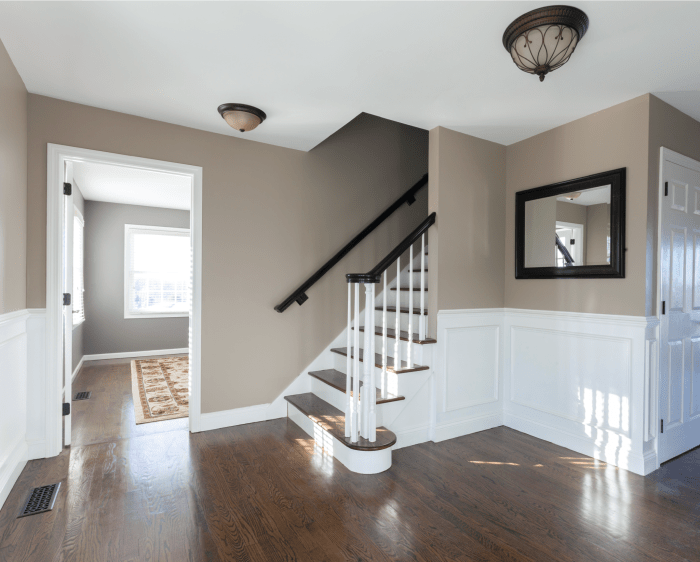Painting house interior sets the stage for this enthralling narrative, offering readers a glimpse into a story that is rich in detail and brimming with originality from the outset. From planning and preparation to selecting the right tools and materials, this guide covers all aspects of transforming your living space through the art of painting.
As we delve deeper into each step of the painting process, you'll discover valuable insights and practical tips to help you achieve professional results and create a space that reflects your unique style and personality.
Planning for Interior Painting
When planning to paint the interior of a house, there are several important steps to consider in order to achieve a successful outcome. From selecting paint colors to calculating the quantity of paint needed, proper planning is key to a successful painting project.
Factors to Consider when Choosing Paint Colors
When choosing paint colors for different rooms, it is important to consider the following factors:
- The purpose of the room: Consider the function of the room and choose colors that align with the desired ambiance. For example, calming colors like blue or green are ideal for bedrooms, while vibrant colors like yellow or red are suitable for living areas.
- Natural light: Take into account the amount of natural light the room receives. Lighter colors can help brighten a room with limited natural light, while darker colors can create a cozy atmosphere in well-lit spaces.
- Room size: Light colors can make a small room feel more spacious, while dark colors can add warmth and intimacy to a large room.
- Existing decor: Consider the existing furniture and decor in the room when choosing paint colors to ensure a cohesive and harmonious look.
Calculating Paint Quantity Based on Room Size
When calculating the quantity of paint needed for a room, you can follow this simple formula:
Paint Quantity = (Room Perimeter x Room Height) / Coverage per Gallon
- Measure the perimeter of the room by adding the length of all four walls.
- Multiply the room perimeter by the height of the walls to determine the total square footage to be painted.
- Divide the total square footage by the coverage per gallon of the paint you intend to use to determine the number of gallons needed.
- It is advisable to purchase slightly more paint than calculated to account for touch-ups and multiple coats if necessary.
Preparing the Space
Before starting the painting process, it is crucial to prepare the space properly to ensure a smooth and successful outcome.
One of the first steps in preparing the room for painting is cleaning the walls. Dust, dirt, and grime can affect the adhesion of paint, leading to an uneven finish. Be sure to wash the walls thoroughly with a mild detergent and water solution, and allow them to dry completely before painting.
Additionally, it is important to inspect the walls for any imperfections that need to be addressed. Fill in any holes or cracks with spackling compound, and sand down any rough areas to create a smooth surface for painting.
Using Drop Cloths and Painter’s Tape
- Use drop cloths to protect floors, furniture, and fixtures from paint splatter and drips. Place them strategically in the room to cover the entire floor area and any furniture that cannot be moved.
- Painter's tape is essential for achieving clean and crisp paint lines. Apply the tape along the edges of trim, ceilings, and any other areas where you want to avoid getting paint. Make sure to press down firmly on the tape to create a tight seal.
- Remember to remove the painter's tape carefully after painting to prevent any peeling or damage to the freshly painted surfaces.
Selecting the Right Tools and Materials

When it comes to painting the interior of a house, using the right tools and materials is essential for achieving a professional finish and ensuring the longevity of the paint job.
- Paint Brushes: Choose between natural bristle brushes for oil-based paints and synthetic brushes for latex paints. Consider the size and shape of the brush based on the surface to be painted.
- Rollers: Select a roller nap that is suitable for the texture of the surface. Short nap rollers are ideal for smooth surfaces, while longer nap rollers are better for textured surfaces.
- Paint Finishes: Decide on the type of finish based on the desired look and the functionality of the space. Matte finishes are great for hiding imperfections, while semi-gloss and gloss finishes are more durable and easy to clean.
Tips for Selecting High-Quality Paints
When choosing paints for your interior walls, opt for high-quality options that offer durability and are easy to apply for a smooth finish.
- Look for Paint Brands with Good Reputation: Choose paints from reputable brands known for their quality and longevity.
- Consider the Paint Sheen: Matte finishes are great for hiding imperfections, while satin and eggshell finishes provide a subtle sheen that is easy to clean.
- Check for Low VOC: Select paints with low or zero volatile organic compounds (VOCs) to minimize harmful emissions and ensure a healthier indoor environment.
- Consult with Professionals: If you're unsure about the right type of paint for your project, don't hesitate to seek advice from painting professionals or store experts.
Painting Techniques
When it comes to painting the interior of your house, mastering different painting techniques can make a significant difference in the final result. Whether you are brushing, rolling, or cutting in, knowing the right techniques can help you achieve clean lines, even coverage, and create various effects on your walls.
Brushing
- Use high-quality brushes for better results.
- Start with the edges and corners before moving on to larger areas.
- Apply smooth and even strokes to avoid brush marks.
- Clean your brushes thoroughly after each use to maintain their quality.
Rolling
- Choose the appropriate roller cover based on the type of surface you are painting.
- Roll in one direction to maintain consistency in texture.
- Overlap each pass slightly to ensure even coverage.
- Avoid pressing too hard on the roller to prevent uneven application.
Cutting In
- Use an angled brush to cut in along edges and corners.
- Apply steady pressure to create clean lines.
- Work in small sections to prevent the paint from drying too quickly.
- Practice patience and precision for a professional finish.
Creating Effects
- For stripes, use painter's tape to create straight lines and alternate colors.
- For ombre effects, blend different shades of the same color seamlessly from top to bottom.
- For stenciled patterns, secure the stencil firmly to the wall and use a dry brush or roller to apply the paint.
- Experiment with different techniques and have fun with creating unique effects on your walls.
Dealing with Challenges
When painting the interior of a house, there are several common challenges that may arise. It's essential to be prepared to face these challenges and know how to overcome them to ensure a successful paint job.
Paint Drips
Paint drips can be a common issue while painting interior walls. To prevent paint drips, make sure to use the right amount of paint on your roller or brush. Avoid overloading them with paint, as this can lead to drips.
If you do notice a drip, quickly smooth it out with a brush before it dries.
Uneven Coverage
Uneven coverage can occur if the paint is not applied evenly on the walls. To avoid this, make sure to use long, even strokes when painting. If you do notice uneven coverage, allow the paint to dry completely before applying a second coat.
This will help even out any imperfections.
Color Bleeding
Color bleeding happens when the old paint color seeps through the new paint. To prevent color bleeding, use a high-quality primer before painting. This will create a barrier between the old and new paint colors. If you do notice color bleeding, apply an additional coat of primer before painting again.
Fixing Mistakes After Drying
If you notice any mistakes or imperfections after the paint has dried, don't worry. You can easily fix them by sanding the area lightly and applying a touch-up coat of paint. Make sure to blend the touch-up coat with the surrounding area to ensure a seamless finish.
Finishing Touches and Clean-Up
After completing the painting process, it's crucial to focus on the finishing touches and clean-up to ensure a professional and polished look for your newly painted interior. This includes removing painter's tape, performing touch-ups, and properly cleaning up the tools and space.
Removing Painter’s Tape and Touch-Ups
- Slowly and carefully peel off painter's tape to avoid damage to the painted surface. Pull the tape at a 45-degree angle for clean lines.
- Inspect the walls for any areas that may require touch-ups, such as uneven paint coverage or missed spots. Use a small brush to carefully fix these imperfections.
- Allow the touch-up paint to dry completely before evaluating if additional touch-ups are needed for a seamless finish.
Cleaning Up After Painting
- Start by cleaning your brushes and rollers immediately after use to prevent the paint from drying and hardening on the bristles. Use warm, soapy water for water-based paints and paint thinner for oil-based paints.
- Thoroughly rinse the brushes and rollers until the water runs clear, removing all traces of paint. Use a brush comb to remove excess paint and maintain the shape of the bristles.
- Wipe down all surfaces, including floors and countertops, to remove any paint splatters or spills. Use a damp cloth for water-based paints and a solvent for oil-based paints.
Maintaining Freshly Painted Walls
- Avoid harsh cleaning products that can damage the painted surface. Use a mild detergent and water solution to clean walls when necessary.
- Regularly dust and vacuum the walls to prevent dust buildup, which can dull the paint finish over time.
- Address any stains or marks promptly to prevent them from setting into the paint. Blot the stains gently with a damp cloth and mild soap, avoiding scrubbing or abrasive cleaners.
Last Word

In conclusion, painting the interior of your house is not just about adding color to walls; it's about creating a home that resonates with warmth and character. By following the guidelines Artikeld in this comprehensive guide, you'll be well-equipped to tackle any painting project with confidence and creativity.
Essential FAQs
How do I choose the right paint color for different rooms?
Consider factors like natural light, room size, and desired mood to select the perfect paint color for each space.
What are some common challenges during interior painting?
Common challenges include paint drips, uneven coverage, and color bleeding, which can be overcome with proper techniques and solutions.
How do I maintain freshly painted walls for longevity?
Regular cleaning and maintenance, as well as avoiding harsh chemicals, can help preserve the quality and durability of painted walls.
